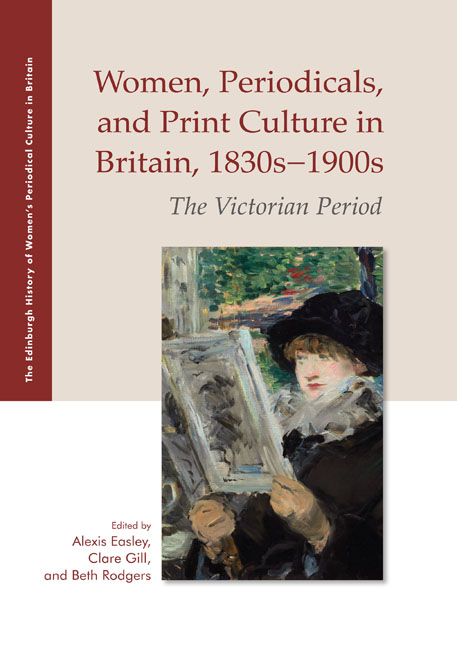Book contents
- Frontmatter
- Contents
- List of Illustrations
- Acknowledgments
- Introduction: Women, Periodicals, and Print Culture in the Victorian Period
- Part I (Re)Imagining Domestic Life
- (Re)Imagining Domestic Life: Introduction
- 1 The Rise and Rise of the Domestic Magazine: Femininity at Home in Popular Periodicals
- 2 Regulating Servants in Victorian Women's Print Media
- 3 Women Editors’ Transnational Networks in the Englishwoman's Domestic Magazine and Myra's Journal
- 4 Women and Family Health in the Mid-Victorian Family Magazine
- 5 Negotiating Female Identity in Nineteenth-Century Ireland
- 6 Women and the Welsh Newspaper Press: The Cambrian News and the Western Mail, 1870–1895
- Part II Constructing Modern Girls and Young Women
- Part III Women and Visual Culture
- Part IV Making Space for Women
- Part V Constructing Women Readers and Writers
- Part VI Intervening in Political Debates
- Notes on Contributors
- Index
- Plate section
(Re)Imagining Domestic Life: Introduction
from Part I - (Re)Imagining Domestic Life
Published online by Cambridge University Press: 25 October 2019
- Frontmatter
- Contents
- List of Illustrations
- Acknowledgments
- Introduction: Women, Periodicals, and Print Culture in the Victorian Period
- Part I (Re)Imagining Domestic Life
- (Re)Imagining Domestic Life: Introduction
- 1 The Rise and Rise of the Domestic Magazine: Femininity at Home in Popular Periodicals
- 2 Regulating Servants in Victorian Women's Print Media
- 3 Women Editors’ Transnational Networks in the Englishwoman's Domestic Magazine and Myra's Journal
- 4 Women and Family Health in the Mid-Victorian Family Magazine
- 5 Negotiating Female Identity in Nineteenth-Century Ireland
- 6 Women and the Welsh Newspaper Press: The Cambrian News and the Western Mail, 1870–1895
- Part II Constructing Modern Girls and Young Women
- Part III Women and Visual Culture
- Part IV Making Space for Women
- Part V Constructing Women Readers and Writers
- Part VI Intervening in Political Debates
- Notes on Contributors
- Index
- Plate section
Summary
WE BEGIN THE VOLUME with a group of essays that considers a topic fundamental to our understanding of Victorian lives and print culture: domestic life and the domestic ideal. In recent decades, a range of scholarly works has expanded our understanding of the complex and often contradictory nature of Victorian domesticity, together with the particular ideals of femininity and the middle-class family so often associated with it. Influential work in the 1980s and 1990s by literary scholars such as Mary Poovey (1988) and Elizabeth Langland (1995) addressed how fictional depictions of the domestic world engaged with, resisted, and reinforced debates about class, gender, and various forms of cultural authority. More recently, studies of domesticity have considered the ways in which the physical spaces of the middle-class home, alongside representations of those spaces, worked to inscribe, and to some degree undermine, the ideology of separate spheres for men and women. Print media, including conduct books, advice literature, and, importantly for our purposes, newspapers and magazines, played a key role in the construction and popularisation of these ideas, which produced, among other tropes, the image of the angelic, domestic Victorian woman so ubiquitous in Victorian print culture.
Margaret Beetham's pioneering work has played an important role in bringing to light the interconnectedness of domestic ideology and periodical culture. As she notes in A Magazine of Her Own?: Domesticity and Desire in the Woman's Magazine, 1800–1914 (1996), ‘Like the nineteenth-century middle-class home, the woman's magazine evolved during the [nineteenth] century as a “feminised space.” It was defined by the woman who was at its centre and by its difference from the masculine world of politics and economics’ (3). Yet the various slippages and sleights of hand – ‘the potential mismatch between “femininity” and historical women’ – used to define the ideal reader of such magazines meant that these ‘feminised spaces’ had a ‘radical potential’ to ‘challenge oppressive and repressive models of the feminine’ (3). In her contribution to this volume, ‘The Rise and Rise of the Domestic Magazine: Femininity at Home in Popular Periodicals,’ Beetham offers a valuable overview of the emergence of the domestic magazine across the second half of the nineteenth century.
- Type
- Chapter
- Information
- Women, Periodicals and Print Culture in Britain, 1830s–1900sThe Victorian Period, pp. 15 - 17Publisher: Edinburgh University PressPrint publication year: 2019



